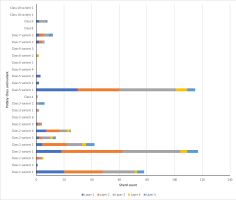

In Trench B we observe the same stratigraphic distribution of the classes and variants as noted in Trench A (Table 11; Figure 39). The only exception to this trend is in layer 1, where examples of Class 5 variant 3 are far less frequent (only three potsherds). The majority of potsherds belong to: Class 1 variant 1; Class 2 variants 1, 2, 4; and Class 5 variant 1, while examples of Class 9 are not distributed as evenly throughout the sequence. Caution is needed when interpreting the distribution of pottery in layers 4 and 5 because the quantity of potsherds is noticeably lower (layer 4: 24 potsherds, layer 5: 36 potsherds) than in other layers (layer 1: 94, layer 2: 141, layer 3: 148). Nevertheless, the similarities to Trench A enable us to propose a comparable date for the layers of Trench B, i.e. from the 4th to the 6th or 7th century CE (Table 12).
| Class/variants | Layer 1 | Layer 2 | Layer 3 | Layer 4 | Layer 5 | Total |
|---|---|---|---|---|---|---|
| Class 1 variant 1 | 20 | 28 | 23 | 2 | 5 | 78 |
| Class 1 variant 2 | 1 | 1 | ||||
| Class 1 variant 3 | 2 | 2 | 1 | 5 | ||
| Class 2 variant 1 | 18 | 44 | 42 | 5 | 8 | 117 |
| Class 2 variant 2 | 4 | 18 | 11 | 3 | 6 | 42 |
| Class 2 variant 3 | 2 | 2 | 6 | 2 | 2 | 13 |
| Class 2 variant 4 | 7 | 10 | 5 | 2 | 1 | 25 |
| Class 2 variant 5 | 1 | 2 | 1 | 4 | ||
| Class 2 variant 6 | 0 | |||||
| Class 3 variant 1 | 2 | 2 | ||||
| Class 3 variant 2 | 2 | 4 | 6 | |||
| Class 4 | 1 | 1 | ||||
| Class 5 variant 1 | 30 | 30 | 41 | 8 | 6 | 115 |
| Class 5 variant 2 | 2 | 2 | ||||
| Class 5 variant 3 | 3 | 3 | ||||
| Class 5 variant 4 | 0 | |||||
| Class 6 variant 1 | 0 | |||||
| Class 6 variant 2 | 1 | 1 | 2 | |||
| Class 6 variant 3 | 0 | |||||
| Class 7 variant 1 | 2 | 2 | 2 | 6 | ||
| Class 7 variant 2 | 2 | 3 | 4 | 3 | 12 | |
| Class 8 | 0 | |||||
| Class 9 | 2 | 5 | 1 | 8 | ||
| Class 10 variant 1 | 0 | |||||
| Class 10 variant 2 | 0 | |||||
| Total | 94 | 141 | 148 | 24 | 36 | 442 |
| Layer | Date range |
|---|---|
| 1 | 7th to 8th century |
| 2 | 4th to 6th/7th century |
| 3 | 4th to 6th/7th century |
| 4 | 4th to 6th/7th century |
| 5 | 4th to 6th/7th century |
Internet Archaeology is an open access journal based in the Department of Archaeology, University of York. Except where otherwise noted, content from this work may be used under the terms of the Creative Commons Attribution 3.0 (CC BY) Unported licence, which permits unrestricted use, distribution, and reproduction in any medium, provided that attribution to the author(s), the title of the work, the Internet Archaeology journal and the relevant URL/DOI are given.
Terms and Conditions | Legal Statements | Privacy Policy | Cookies Policy | Citing Internet Archaeology
Internet Archaeology content is preserved for the long term with the Archaeology Data Service. Help sustain and support open access publication by donating to our Open Access Archaeology Fund.